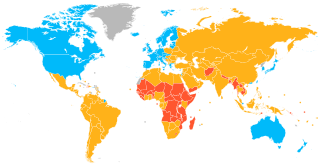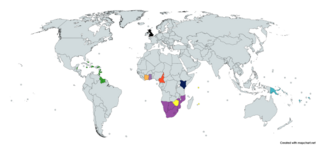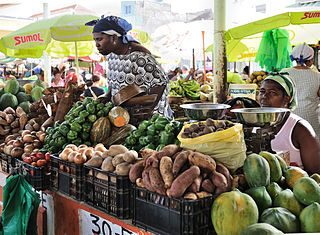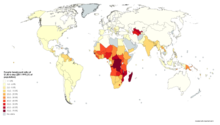
The economy of Bhutan is based on agriculture and forestry, which provide the main livelihood for more than 60% of the population. Agriculture consists largely of subsistence farming and animal husbandry. Rugged mountains dominate the terrain and make the building of roads and other infrastructure difficult. Bhutan is among the richest by gross domestic product (nominal) per capita in South Asia, at $3,491 as of 2022, but it still places 153rd, and among the poorest in the world. The total gross domestic product is only $2,653 million, and 178th according to IMF.

The United Nations Conference on Trade and Development (UNCTAD) is an intergovernmental organization within the United Nations Secretariat that promotes the interests of developing countries in world trade. It was established in 1964 by the United Nations General Assembly (UNGA) and reports to that body and the United Nations Economic and Social Council (ECOSOC). UNCTAD is composed of 195 member states and works with nongovernmental organizations worldwide; its permanent secretariat is in Geneva, Switzerland.

A developing country is a sovereign state with a less developed industrial base and a lower Human Development Index (HDI) relative to other countries. However, this definition is not universally agreed upon. There is also no clear agreement on which countries fit this category. The terms low and middle-income country (LMIC) and newly emerging economy (NEE) are often used interchangeably but refers only to the economy of the countries. The World Bank classifies the world's economies into four groups, based on gross national income per capita: high, upper-middle, lower-middle, and low income countries. Least developed countries, landlocked developing countries and small island developing states are all sub-groupings of developing countries. Countries on the other end of the spectrum are usually referred to as high-income countries or developed countries.
From 1916 to 1975, Tuvalu was part of the Gilbert and Ellice Islands colony of the United Kingdom. A referendum was held in 1974 to determine whether the Gilbert Islands and Ellice Islands should each have their own administration. As a consequence of the referendum, the separate British colonies of Kiribati and Tuvalu were formed. Tuvalu became fully independent as a sovereign state within the Commonwealth on 1 October 1978. On 5 September 2000, Tuvalu became the 189th member of the United Nations.

The South Asian Free Trade Area (SAFTA) is a 2004 agreement that created a free-trade area of 1.6 billion people in Afghanistan, Bangladesh, Bhutan, India, the Maldives, Nepal, Pakistan and Sri Lanka with the vision of increasing economic cooperation and integration.

Everything but Arms (EBA) is an initiative of the European Union under which all imports to the EU from the least developed countries are duty-free and quota-free, with the exception of armaments. EBA entered into force on 5 March 2001. There were transitional arrangements for bananas, sugar and rice until January 2006, July 2009 and September 2009 respectively. The EBA is part of the EU Generalized System of Preferences (GSP). The up-to-date list of all countries benefiting from such preferential treatment is given in Annex IV of the consolidated text of Regulation (EU) 978/2012.
The landlocked developing countries (LLDC) are developing countries that are landlocked. Due to the economic and other disadvantages suffered by such countries, the majority of landlocked countries are least developed countries (LDCs), with inhabitants of these countries occupying the bottom billion tier of the world's population in terms of poverty. Outside of Europe, there is not a single highly developed landlocked country as measured by the Human Development Index (HDI), and nine of the twelve countries with the lowest HDI scores are landlocked. Landlocked European countries are exceptions in terms of development outcomes due to their close integration with the regional European market. Landlocked countries that rely on transoceanic trade usually suffer a cost of trade that is double that of their maritime neighbours. Landlocked countries experience economic growth 6% less than non-landlocked countries, holding other variables constant.

Economic Partnership Agreements (EPAs) are a scheme to create a free trade area (FTA) between the European Union and other countries. They are a response to continuing criticism that the non-reciprocal and discriminating preferential trade agreements offered by the EU are incompatible with WTO rules. The EPAs date back to the signing of the Cotonou Agreement. The EPAs with the different regions are at different states of play. The EU has signed EPAs with the following countries: the Southern African Development Community (SADC), ECOWAS, six countries in Eastern and Southern Africa, Cameroon, four Pacific states, and the CARIFORUM states. Their defining characteristic is that they open up exports to the EU immediately, while exports to the partner regions is opened up only partially and over transitioning periods.
The G90, otherwise known as the Group of 90, is an alliance between the poorest and smallest developing countries, many of whom are part of the World Trade Organization (WTO). The G90 emerged as a strong grouping at the WTO’s Ministerial conference at Cancun in September 2003, taking common positions representing the largest number of countries, with 64 of the 90 countries in the G90 being members of the WTO. It is the largest trading body in the WTO, and it was formed as an umbrella body including the African, Caribbean and Pacific Group (ACP), the African Union, and the group of Least Developed Countries (LDC).

The Centre for Policy Dialogue (CPD), established in 1993 by Rehman Sobhan, its Founder chairman, with support from leading civil society institutions in Bangladesh, is mandated by its Deed of Trust to service the growing demand originating from the emerging civil society of Bangladesh for a more participatory and accountable development process. CPD seeks to address this felt-need from the perspectives of marginalised stakeholders, by way of organising multistakeholder consultations, by conducting research on issues of critical national, regional and global interests, through dissemination of knowledge and information on key developmental issues, and by influencing the concerned policy making processes.

The economy of Cape Verde is a service-oriented economy that is focused on commerce, trade, transport and public services. Cape Verde is a small archipelagic nation that lacks resources and has experienced severe droughts. Agriculture is made difficult by lack of rain and is restricted to only four islands for most of the year. Cape Verde's economy has been steadily growing since the late 1990s, and it is now officially considered a country of average development, being only the second African country to have achieved such transition, after Botswana in 1994. Cape Verde has significant cooperation with Portugal at every level of the economy, which has led it to link its currency first to the Portuguese escudo and, in 1999, to the euro.
Tuvalu became the 189th member of the United Nations in September 2000. Tuvalu is one of 14 states not recognising the People's Republic of China. The country has played a role in advocating for more ambitious international cooperation on mitigating climate change, given the country's vulnerability to its impacts.

The Global System of Trade Preferences among Developing Countries(G.S.T.P) is a preferential trade agreement, currently encompassing 42 members (“participants”), signed on 13 April 1988 with the aim of increasing trade between developing countries. It was negotiated within the framework of the United Nations Conference on Trade and Development (UNCTAD). The Agreement entered into force on 19 April 1989 and was notified to the then General Agreement on Tariffs and Trade (GATT), predecessor of the World Trade Organization (WTO), on 25 September 1989. The 42 members of GSTP include 7 LDCs as well.
The Enhanced Integrated Framework for Trade-Related Assistance for the Least Developed Countries is a global development program with the objective of supporting least developed countries (LDCs) to better integrate into the global trading system and to make trade a driver for development. The multi-donor program was launched on 1 January 2007 as the successor of the Integrated Framework for Trade-Related Technical Assistance to the Least-Developed Countries, which existed from October 1997 to December 2006. The second phase of the EIF has started on 1 January 2016 and will last for 7 years.
The United Nations Office of the High Representative for the Least Developed Countries, Landlocked Developing Countries and Small Island Developing States (UN-OHRLLS) is an office of the United Nations Secretariat which deals with the Least Developed Countries, Landlocked Developing Countries, and Small Island Developing States. It was founded in 2001 by United Nations resolution 56/227.
The Sopoaga Ministry was the 14th ministry of the Government of Tuvalu, led by Prime Minister Enele Sopoaga. It succeeds the Telavi Ministry upon its swearing in by Governor-General Sir Iakoba Italeli on 5 August 2013.
Fahmida Khatun is a Bangladeshi economist who focuses on policy analysis and project management.

Dorothy (Ng’ambi) Tembo is a Zambian economist and trade and development expert. She is the deputy executive director of the International Trade Centre (ITC), a joint agency of the United Nations and the World Trade Organization.

Aid for Trade is an initiative by the World Trade Organization (WTO), as well as a policy concept in international economic and trade development, concerned with helping developing countries and particularly the least developed countries build trade capacity and infrastructure.
Duty Free Tariff Preference (DFTP) is a unilateral non-reciprocal preferential tariff scheme provided by the Government of India for the least developed countries (LDCs). The scheme was officially introduced on 13 August 2008. India was the first developing country to introduce a preferential tariff program for the LDCs.














